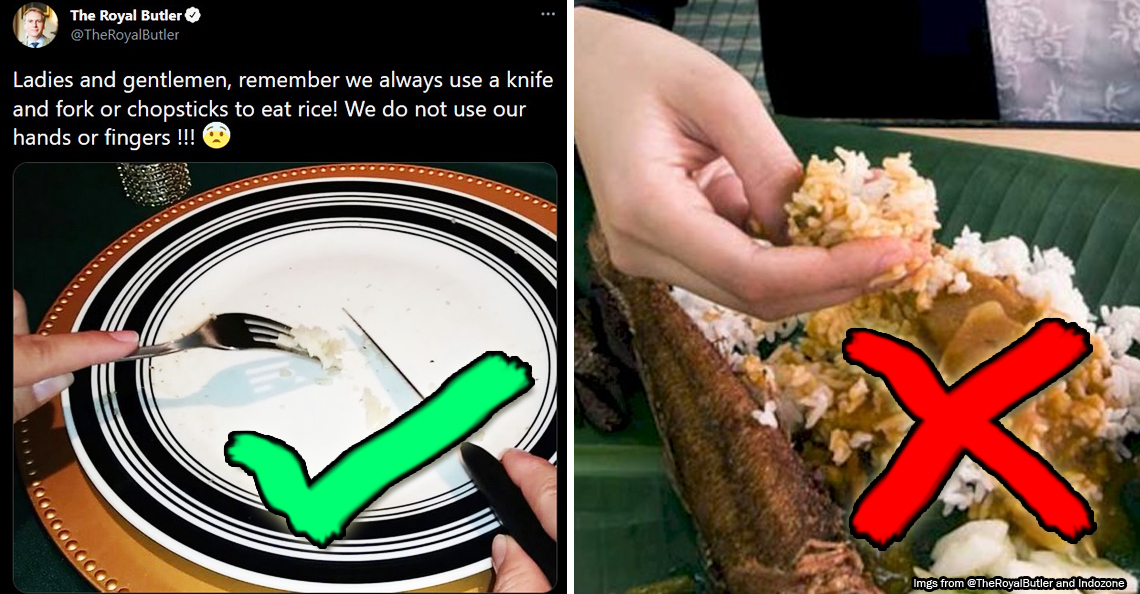7 Malaysian things that might be considered ‘bad manners’ by etiquette experts

- 623Shares
- Facebook612
- Email2
- WhatsApp9
As Malaysians, few of us can deny the simple pleasure of eating rice with our hands. So if you scrolled through Twitter sometime last week, you might’ve had a little shock:

That’s a Tweet from Grant Harold aka @TheRoyalButler, aka the ‘Defender of British Etiquette‘. Drama ensued, as quite a few Asians felt that the Tweet is an attack on their culture, while others felt that it’s just impractical.
We know that the Tweet may not be directed to Asians in particular, but it did highlight how different cultures see certain things differently. Eating rice with our hands is so common in Malaysia that nobody would look at you weird for doing it, but apparently it warrants a ‘😨’ emoji by a person selling etiquette courses in Britain.
So what other rude stuff have we been doing then? To find out, we pored through several etiquette guides and made a list of the rude things we commonly do, in the eyes of European/American culture.
Here are some common ‘bad etiquette’ by Malaysians
A lot of etiquette is just common sense and being polite, so we won’t cover obvious ones like being late and catcalling. Here are some of the more counterintuitive ones.
1. Joining a crowd at a pasar malam

It was considered bad etiquette to stop and join a crowd gathering around a street show, or a street merchant. The reason behind this is that you’ll look like very kampung wan.
“Do not stop to join a crowd who are collected round a street show, or street merchant, unless you wish to pass for a countryman taking a holiday in the city.” – excerpt from The Gentlemen’s Book of Etiquette, 1860.
2. Running while crossing a street, if you’re a lady
In Malaysia, if you don’t run while crossing a street, expect to go viral later that night. But ladies back then were expected to wait until the roads are clear enough that they can leisurely walk across, as it’s not very ladylike to run.
“Stop! don’t you see there is a carriage coming? Do you want to be thrown down by the horses? You can run across? Very lady-like indeed! Surely nothing can be more ungraceful than to see a lady shuffle and run across a street. Wait until the way is clear and then walk slowly across.” – excerpt from The Ladies’ Book of Etiquette, and Manual of Politeness, 1860.
3. Forcing people to eat more
Aunties asking you to eat more food when you visit and people putting more lauk in your plate/bowl are forms of affection and hospitality here, but that’s considered a bit rude for wypipo. Etiquette demands that you ask a guest if you want to tambah/try a particular dish only once, and if they refuse, don’t press them. This regardless of how shy you think your guests are, or how much they might be missing out.
4. Introducing your children to visiting guests

It’s common for us to ask our children to come out of their rooms and greet visitors, but you guessed it, bad etiquette. This was on the assumption that children are wet blankets to a proper gathering, so unless your guests insist on meeting them, don’t bring them out.
“If you should happen to be blessed with those rely [sic] nuisances, children, and should be entertaining company, never allow them to be brought in after dinner, unless they are particularly asked for, and even then it is better to say they are at school.” – excerpt from The Laws of Etiquette, 1836.
5. Asking people about their professions
For context, this is for social gatherings where you meet new people. A common conversation topic for us is what people do for a living – if you find out someone is a teacher, the conversation should naturally flow to school and teaching matters, right? Well, bad etiquette. Don’t talk business while people are trying to enjoy themselves, boi!
“Do not talk of politics with a journalist, of fevers to a physician, of stocks to a broker,– nor, unless you wish to enrage him to the utmost, of education to a collegian… it betrays to a gentleman, ignorance of the world–to a philosopher, ignorance of human nature.” – excerpt from The Laws of Etiquette, 1836.
6. Asking questions to start a conversation
Another social gathering thing. Besides potentially getting an awkward answer, it’s impolite to put people on the spot with questions, because then it’ll be impolite to not answer. It’s better to use statements as conversation starters instead: for example, instead of “Aiya ah boy, when are you getting married?“, try “Ah boy ah, I hope your girlfriend is doing well.” Ah boy will then have more options in answering.
7. Not bringing a girl’s mom along for a first date

If you’re taking a lady out on a first date, it’s proper etiquette to also invite either your date’s mother, sister, or some other lady to come along. We were told that some traditional Malaysian ladies still bring along a third wheel on first dates, though, so that’s kinda cute.
There are plenty more we’re not mentioning here, so you can click the links above to read the books we’ve referenced to find out more. But by now you might be wondering…
Wah, why is proper etiquette so mafan wan?

Etiquette started out as a way for upper class people to distinguish themselves from the lower classes, so you can tell who’s more socially atas just through observation. Most of it is generally making yourself a more pleasant person who can fit in with the elites of society, but other parts, like the whole fork and knife thing, can be seen as a form of snobbery by some. So while there’s nothing wrong with expecting people to be more polite and well-mannered, the proper etiquette is to accept that different cultures and times have different expectations of good manners.
“We may define politeness, though we cannot tell where to fix it in practice. It observes received usages and customs, is bound to times and places, and is not the same thing in the two sexes or in different conditions.” – Jean de la Bruyére, French author.
Going back to the fork and knife for rice thing, some of the guides mentioned that you shouldn’t use a knife for foods that you can scoop/cut with a fork, like fish or peas. Rice definitely falls in that category, so we guess different groups within a culture may also have different etiquette expectations as well.
“It need hardly be said that it would be a vulgarity to eat peas with a knife, although those who reside abroad, or who are in the habit of traveling on the continent, are not unaccustomed to seeing this done by foreigners who are well-bred men.” – excerpt from Manners and Rules of Good Society, 1916.
Bearing all these differences in mind, there shouldn’t be a pressure for anyone to adapt to a specific, fixed kind of etiquette. Taking a local proverb as a final lesson here, just buang yang keruh, ambil yang jernih.
- 623Shares
- Facebook612
- Email2
- WhatsApp9
